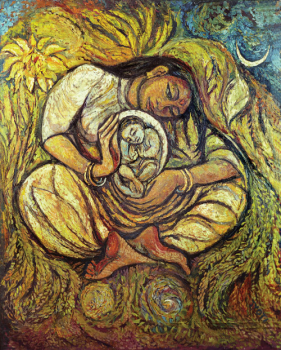The Methodist art collection comes to town

The Dalit Madonna by Jyoti Sahi
When we were first married we worshipped in a village Methodist Church near Margate; an austere little chapel it was, whitewashed walls and uncomfortable benches. Thank God we did not have to sit under hour long nineteenth century non-conformist sermons, but were fed with wise words from Fr Martin Symonds, of Ramsgate Abbey. That was more than a few years ago, but the austere image of Methodism is fixed in my mind, which expects churches to be bathed in coloured light from stained glass windows and peopled by statues of the saints who have gone before us. Not all windows or statues in English Catholic churches would merit inclusion in a travelling art exhibition.
The Methodist Church has built up a collection of modern art, largely looking at Jesus, in one way or another. You can view the works here:
See: www.methodist.org.uk/prayer-and-worship/mmac/index . The website will lead you to videos and other resources around these images.
Instead of hanging on church walls, the collection is sent out to proclaim the Good News in its own way; through exhibitions around the UK and in the future to Dublin, Rome and beyond. Until Saint George's Day 2017 it is in Canterbury's Beaney Museum.
Not all the images inspire me to 'prayer and worship', but I am hard-wired to David Jones, represented here by a delicate woodblock of The Three Kings, passing a David Jones signature passion-resurrection image: a war-blasted tree-cum-cross, sprouting new growth. The Magi approach a starlit Bethlehem amid Welsh hills that bring to mind a woman's torso and raised knees at the moment of childbirth: the star's rays beam down like a searchlight upon the haven where the Child lies, under the hill within his Mother's womb.
Next to Jones's tiny, monochrome image hangs The Dalit Madonna, a big, bright work by Jyoti Sahi. While this glorious work picks up themes from Eastern and Western European tradition, such as the sun and moon in the sky, and the Babe blessing from the womb, the artist integrates these with his own Indian culture. The sun is represented by a marigold; the moon by a crescent, including Hinduism and Islam in this birth. Then the Infant is seated within an oval reminiscent of the traditional mandala of Eastern icons, yet despite his foetal position and naturalistic drawing, he is clearly blessing the viewer; he is strong but clearly dependent on his mother, who bends her body in worship and protection, her breast ready to comfort and nurture. Many Catholic preachers would tell you that Mary, who conceived Jesus before her marriage, would have been considered an outcast; an untouchable like this Dalit mother, a radiant human being who clearly loves her son, the centre of her world and being. And how many unwed mothers were condemned by the Catholic Church in recent times?
The one Old Testament story on view here is that of Cain and Abel. We could be among Jones's Welsh hills, or the Lake District, or even the Downs of the Isle of Wight where John Reilly lived and worked. Cain is a stocky, almost Calibanesque figure, at work within the pale he has set around his neat, well-ordered, smallholding. He pauses in his digging to stare up at his brother, a slim, radiant type of the Good Shepherd, who like Abel would be killed by his own. Suddenly that spade looks menacing: a ploughshare about to become a sword. And yet one cannot help a twinge of sympathy for one who wants his world to be under control, without any disturbing incursions from his brother's nomadic flocks; that brother who stands nearby with eyes for the far horizon, not for him.
The Lord's eyes, too, are on a far horizon in Christ writes in the dust - the woman taken in adultery by Clive Hicks Jenkins. In a nightmare of blues, Jesus is almost cartwheeling as, with arms outstretched as on the Cross, he looks away from the scene, away from the woman and her accusers, away from us bystanders looking on. The woman, with her Magdalenesque red hair, high heels and little black dress, is bound, as Christ soon would be, a halter around her throat.The light that glows upon her skin is reflected from Christ, apart from the tiny white triangle of her underwear, visible beneath her skirt which she cannot pull down with her hands tied behind her back. It takes a few moments to see that her accusers already have rocks in their hands, awaiting the moment when Christ's assent to her killing is given. A moment that never comes. Would we back these men up, if we were there? Were these the men who stoned Stephen? Was Paul among them? Was this the first step on the road to Damascus? Go and sin no more, Jesus told that woman. A good motto for the Christian life.
Even in the first two pictures reviewed here, the effects of sin creep in: the tree from Flanders, the outcast mother. We see the sin in Cain's illusory self-sufficiency and his inherent jealousy; loud and clear in those shadowy, self-righteous stones, poised for murder. But like Jones's three kings, each of us can follow the star, which leads us to a fleshly, humble place. The damage of our sinfulness will not prevent the Cross from being the tree of Life.
If you get the chance to see this exhibition on its travels, do spend some time with a few of the works. Others among them may speak to you louder than these four have done to me. Stop, look, listen.


















